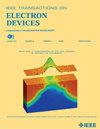N-Type Low-Temperature Polycrystalline Silicon and Amorphous Oxide Thin-Film Transistor-Based Robust Dual-Output Gate Driver
IF 2.9
2区 工程技术
Q2 ENGINEERING, ELECTRICAL & ELECTRONIC
引用次数: 0
Abstract
This work presents a dual-output gate driver that is based on low-temperature polycrystalline silicon and amorphous oxide (LTPO) thin-film transistors (TFTs) and supports bidirectional transmission. This gate driver generates positive and negative pulses for both n-type and p-type switching TFTs in display pixels, effectively reducing the bezel area. Simulation results indicate that the output waveforms remain undistorted even when the threshold voltage (基于 N 型低温多晶硅和非晶氧化物薄膜晶体管的稳健双输出栅极驱动器
这项研究提出了一种基于低温多晶硅和非晶氧化物(LTPO)薄膜晶体管(TFT)并支持双向传输的双输出栅极驱动器。这种栅极驱动器可为显示像素中的 n 型和 p 型开关 TFT 生成正脉冲和负脉冲,从而有效减少边框面积。仿真结果表明,即使低温多晶硅(LTPS)TFT 的阈值电压(${V}_{text {TH}}$ )变化±0.46 V,非晶铟镓锌氧化物(a-IGZO)TFT 的${V}_{text {TH}}$ 变化+0.56 V,输出波形也不会失真。在正向传输过程中,该栅极驱动器通过由 LTPS TFT 组成的输出电路实现了短的上升/下降时间,正脉冲约为 1.25/ 1.42~\mu $ s,负脉冲约为 1.55/ 2.73~\mu $ s。当工作频率为 1 Hz 时,输出波形正确产生,并通过包括 a-IGZO TFT 的稳定电路稳定在 +6.6 V 和 -6.6 V。因此,所提出的栅极驱动器有望用于低帧频智能手表显示器。
本文章由计算机程序翻译,如有差异,请以英文原文为准。
求助全文
约1分钟内获得全文
求助全文
来源期刊

IEEE Transactions on Electron Devices
工程技术-工程:电子与电气
CiteScore
5.80
自引率
16.10%
发文量
937
审稿时长
3.8 months
期刊介绍:
IEEE Transactions on Electron Devices publishes original and significant contributions relating to the theory, modeling, design, performance and reliability of electron and ion integrated circuit devices and interconnects, involving insulators, metals, organic materials, micro-plasmas, semiconductors, quantum-effect structures, vacuum devices, and emerging materials with applications in bioelectronics, biomedical electronics, computation, communications, displays, microelectromechanics, imaging, micro-actuators, nanoelectronics, optoelectronics, photovoltaics, power ICs and micro-sensors. Tutorial and review papers on these subjects are also published and occasional special issues appear to present a collection of papers which treat particular areas in more depth and breadth.
 求助内容:
求助内容: 应助结果提醒方式:
应助结果提醒方式:


